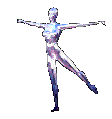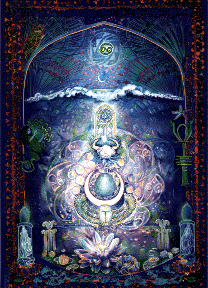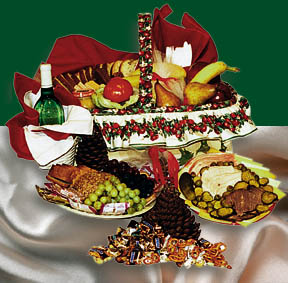
Chakras and Meditation
According to East Indian philosophy, man possesses seven major *Chakras*
or psychic centers on his body.
Each of these forms a bridge, link, or energy transformer;
changing pure (higher) energy into various forms,
and connecting the four bodies
(ie. spiritual, mental, astral, and physical)together.
The chakras are located along the nadies
(a network of psychic nerves or channels)
and follow the autonomic nervous system along the spinal cord.
Chakras correlate with major acupuncture points
along the 'governing vessel meridian' (acupuncture term).
The seven major chakras are connected together by three major nadies
which are parallel and near each other.
The middle nadi is called *sushumna* and it has neutral characteristics.
The nadi on the left (ie. nearest your left hand)
is the *ida* nadi which has yin characteristics.
On the other side of sushumna (nearest your right hand)
is the *pingala* nadi, having yang qualities.
Chakras are visible to clairvoyant sight as varously colored rotating circles
or funnels. In the East they are described as petaled flowers or lotuses.
Sources disagree on the colors.
Chakra Locations

The first chakra, located at the base of the spine at the perineum
is the *root chakra*, muladhara.
It primarily relates to the element of earth and to psychic smell.
The second chakra, known as the *sacral center, or sexual chakra*,
svadhisthana, is located above and behind the genitals.
Its dominant element is water, and it is related to psychic taste.
Third of the chakras is the *solar plexus*, manipura, located at the navel
and corresponding with the emotions and with the element of fire;
also with psychic sight (clairvoyance).
The *heart chakra*, anahata, is the fourth chakra, located over the heart
and corresponding with the element of air, and also with psychic touch.
The fifth chakra is the *throat chakra*, vishuddha, located at the base of the
throat (thyroid) and corresponding with psychic hearing (clairaudience).
The remaining two chakras are very important.
They relate mostly to elevated states of consciousness.
The *frontal chakra*, (or 'third eye') Ajna, the sixth chakra,
is located between, and slightly above, the eyebrows.
Ajna is the center of psychic powers and can produce many psychic effects.
Meditation on ajna is said to cure nervousness.
Finally, the *crown chakra*, sahasrara, located atop the head,
(pineal gland) is the seventh chakra.
It is referred to as the thousand-petaled lotus and
corresponds with astral projection and enlightenment.
There are also many minor chakras throughout the body.
Each chakra has a sound
(letter) and a pitch which is sometimes used to invoke it.
The Tatvas

Some occultists prefer to describe the magical elements as tattvas
according to the Eastern system.
Notice that these symbols and colors are generally different
than the western symbols and colors for the elements.
Element
Earth
Water
Fire
Air
Spirit Tattva
Prithivi
Apas
Tejas
Vayu
Akasa Tattvic Symbol
Yellow Square
Silver Crescent
Red Triangle
Blue Circle
Black Oval
Yoga

Yoga originated in India.
It is a physical or mental discipline designed to
condition and invigorate the mind and body.
There are many kinds of yoga,
but they may be generally divided into three main types...
Hatha yoga - affect the mind through the body using physical exercises;
improve physical health and endurance.
Raja yoga - affect the mind through mental training; improve concentration.
Mantra yoga -- affect the mind through chanting and affirmation;
achieve relaxation.
Meditation

This is a much touted area of the occult.
There are many meditation techniques,
and many claims made for the benefits of meditation.
Basicly, meditation has two functions --
relaxation, and perhaps, improved concentration.
There are two main types...
1) concentration meditation (focusing),
2) insight meditation (mindfullness).
Most kinds of meditation are the concentrative type.
One simply focuses his attention upon a single physical object
(such as a candle flame);
upon a sensation
(such as that felt while walking or breathing);
upon an emotion
(such as reverence or love);
upon a mantra spoken aloud or even silently;
or upon a visualization (as in chakra meditation, see below)...
Concentration meditation is, simply put, a form of self-hypnosis.
A mantra (or mantrum) is one or more words or syllables
which are repeated -- often chanted -- aloud...
A simple yet powerful mantra is to vibrate the mystical word 'OM'.
This mantra has long been associated in India with the godhead/unity.
Use it to aid in tuning into universal vibrations
which promote feelings of harmony, peace, and well-being.
Use it before magick ritual to
'get into the mood' and afterward to 'dismiss the forces'.
You vibrate a mantra by saying it
slowly aloud in a lower-pitched voice than your normal speech,
and a more or less constant pitch as well.
Let the sound fade at the end of the mantra.
A powerful one such as 'OM' will seem to vibrate the air around you.
It should be vocalized for 5-10 seconds
and repeated a number of times with a few seconds
rest between each vocalization.
Chanting of mantras may cause slight dizziness from hyperventilation.
The other main type
of meditaiton -- insight meditation --
is the analysis of thoughts and feelings in such a way
as to cause realization of the subjectivity and illusion of experience.
This is done in a effort to attain trancendental awareness.
Such statements as, 'This body is not me', fall under this category.
Buddhist meditations are usually of this type.
Chakra Meditation

There is a special type of concentrative meditation
which we will call 'Chakra meditation'.
This is basically Kundalini yoga - the practice of causing psychic
energy (kundalini) to flow up sushumna,
energizing the various chakras along the way.
The practice, considered dangerous by some, will produce definite
physiological sensations and psychological effects
if continued long enough. It should not be attempted by epileptics
or persons with an unstable mental or physical condition,
or with heart disease. Certain drugs and medications, such
as those used to treat epilepsy may retard progress.
Although the technique is very simple,
it may eventually produce powerful results.
Results may at first appear hours after the practice during sleep.
As each chakra is energized by this practice,
it is said to add occult powers (sidhis), until at last the crown
chakra is reached, and with it, full enlightenment is attained.
Sometimes kundalini awakens all by itself.
To practice this chakra meditation, you simply concentrate on the chakras,
beginning with the root chakra, and moving progressively up,
as you visualize psychic energy from the root chakra
traveling up shushumna and vivifying each higher chakra.
As we mentioned the chakras have certain properties associated
with them, so that this type of visualization may 'raise consciousness',
promote astral projection, and other things --
once you have reached ajna and eventually the crown chakra.
You might typically meditate in this fashion for 15 minutes to
a half hour a day. It might help to practice some hatha yoga or
other physical exercise in an effort to make the spinal cord
'more flexible'. Diet may also affect the process.
The technique is also similar to the Tibetan 'Tummo' meditation.
The rise of kundalini is sometimes experienced as a 'vibration'
or buzzing, as light, or as heat.
Health and Diet

Certainly the way you treat your physical body will affect your mind.
In magick you want an alert mind.
Therefore, your body must be as healthy as you can keep it.
Take care of your body. Exercise regularly.
Eat a good diet (with vitamin supplements), and do not consume anything
which will have a negative effect upon the mind.
Drugs, smoking, and alcohol should be restricted, or eliminated. (The
mind can create any condition which a drug can create.)
A good rule here is moderation in what and how much you consume.
(Most of this stuff is pretty obvious isn't it?)
You may also want to cut down on sugar and processed foods.
Many occultists advise dietary changes, expecially the non-eating of meat.
We cannot deny the physical, psychological, and spiritual effect
which all foods have.
This effect may be described as the 'heaviness' factor of foods.
Various foods are so ranked in the chart, lighter to heavier...
1. lettuce and other greens.
2. fruits and most vegetables.
3. wheat, rice, and other grains.
4. nuts, beans, and other legumes.
5. cheese, dairy products, including eggs.
6. fish, seafood.
7. chicken, poultry.
8. beef, pork, other red meats.
Note that meats, especially red meats are the 'heaviest' foods.
Generally, foods which are harder to digest,
or which are higher in protein are 'heavier' than those which are not.
Animal products are heavier than plants.
Foods high in carbohydrate (candy, bread, starch) are heavy.
However, the 'heaviness' of foods
is not directly related to the amount of calories.
What this means is that for various reasons,
the heaviness of food in your diet will affect your magical experiences.
You may be able to increase your psychic receptivity ('energy level')
by eating lighter foods, or by eating less.
Conversely, emphasizing heavy foods in your diet,
or eating larger helpings, may help to 'bring you down to earth'
should you 'rent the veil' too much.
These are generalizations, of course,
and it may take a number of days of dietary change
before you notice much effect.
I do not advocate radical dietary changes, excessive fasting, or malnutrition.
Your good health is far more important in magick
than any temporary effect you get from prolonged starvation.
A change in diet will sometimes only produce a temporary effect,
until the physical body adapts to the change.
Healthy natural foods and lifestyle make it easier for us
to be healthy, but ultimately, good health is a mental quality (attitude).
The four fold breath

With physical exercise too, moderation is advised.
(You should be cautious, or not attempt it if you have a respiratory or heart condition.
Check with your physician if in doubt, and don't overdo.)
One of the most useful physical exercises is pranayama,
or controlled breathing (actually a type of hatha yoga exercise).
For this and any other calesthenics or hatha yoga which you might
choose to do a 'kitchen timer' is suggested.
The main purpose of pranayama is to relax the body and mind.
There are many kinds of pranayama,
but a simple one called the 'four-fold breath' will suffice.
This consists of four short quick inhalations,
then four short quick exhalations; then repeat,
continuing until the allotted time is used up.
It will take about 1 1/2 seconds for the four inhalations,
and about 1 1/2 seconds for the four exhalations;
or about 3 seconds for the complete in-out cycle ('rep' for repetition).
There should be no strain of any kind during your pranayama.
You will probably notice a slight dizziness, particularly at first,
since the effect of pranayama is to hyperventilate.
Try sitting back in a chair
with your eyes closed when you do your pranayama.
Begin a minute a day for the first week
and gradually increase up to about five minutes a day.
If you do the pranayama befor your magical activity,
it will help you to get 'into the mood'.
It is also an excellent aid to relaxation and tension release.
Pranayama should not be done during heavy air pollution.
Other exercises you might consider are
hatha yoga, calesthentics, walking or jogging.

Book list:
Arthur Diekman, The Observing Self.
W.Y. Evans-Wentz, Tibetan Yoga and Secret Doctrines.
Sandra Gibson, Beyond the Mind.
King and Skinner, Techniques of High Magic.
Swami Sivananda, Kundalini Yoga.
John Woodroffe (pseud. for Arthur Avalon), The Serpent Power.
Copyright (c) 1988 by Phil Hansford.
This article is is licenced for free non-commercial distribution only.


This
web site designed by Naomi Shifra. All rights reserved. Updated 4/2000.